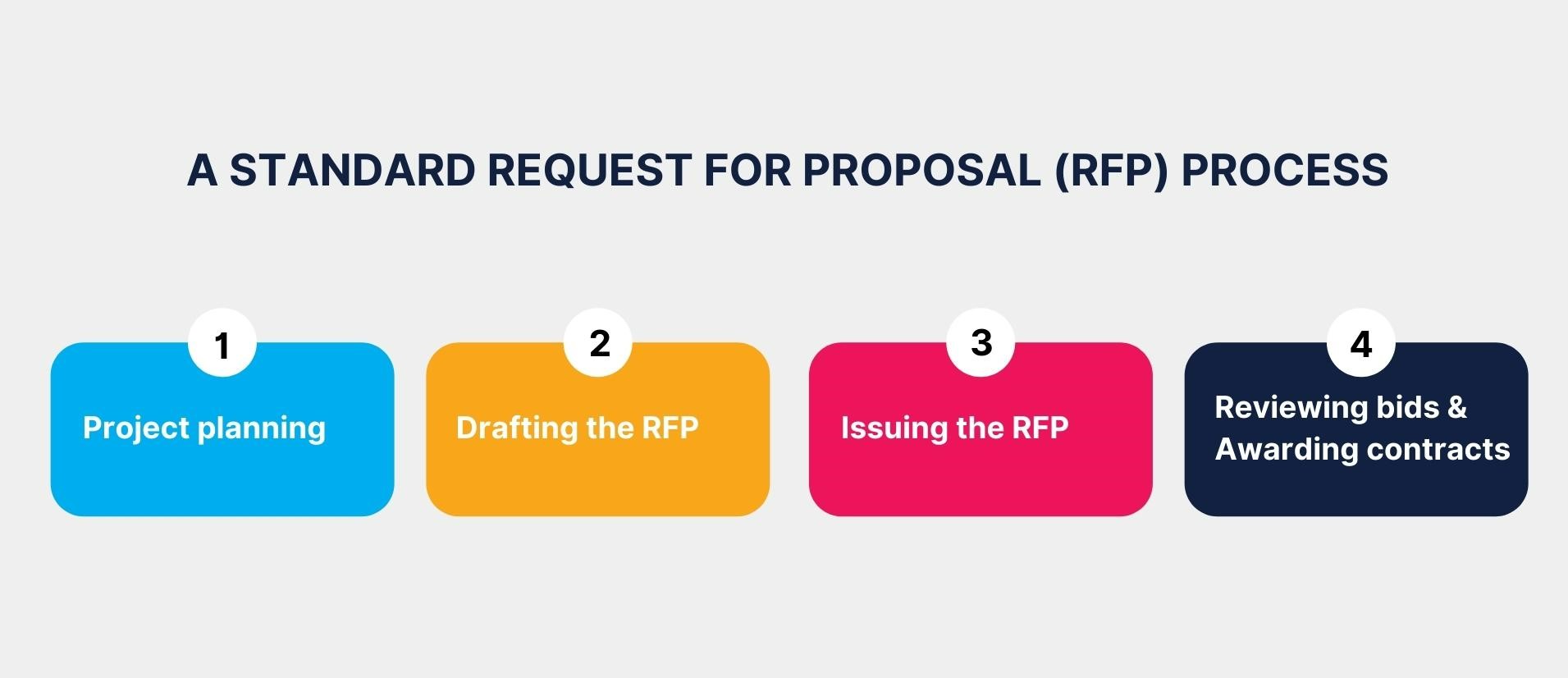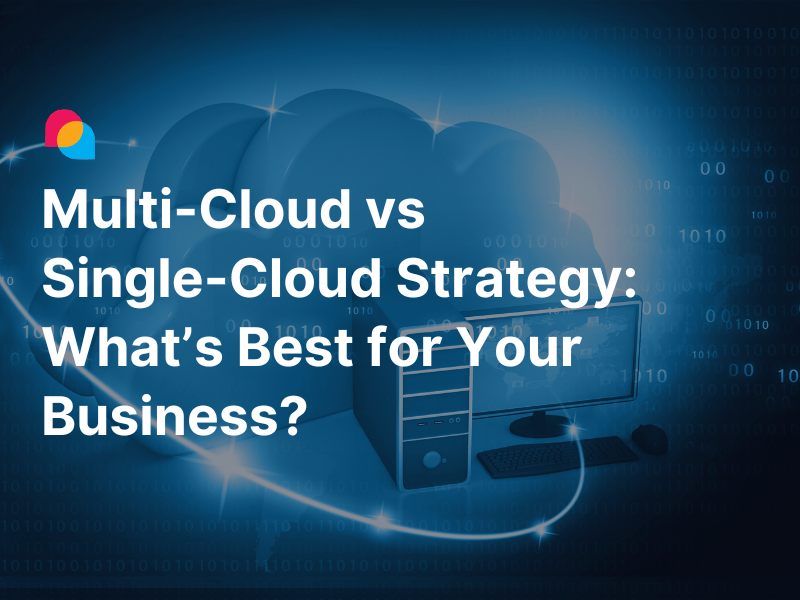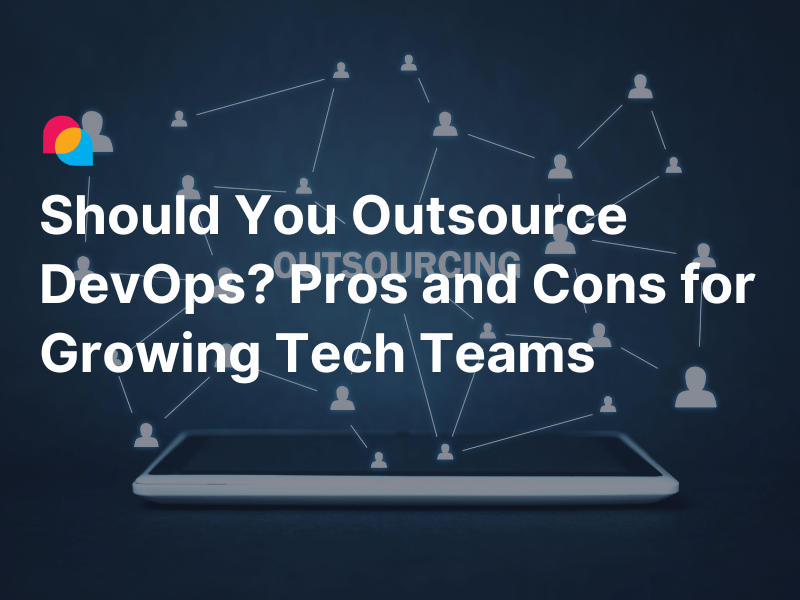According to Forbes Technology Council, one of the most common reasons software projects fail is unclear requirements. Given that, when it comes to seeking out a quality software vendor, businesses need to clearly articulate their requirements in detail from the very early stages. And that's where a request for proposal (RFP) comes into play. An effective RFP promotes transparency, objectivity, clear requirements, and risk reduction. It also enables potential software development providers to collect all the essential information required for submitting the proper bid or consultation. The more clearly you describe your requirements, the more accurate the received technical solutions will be.
In this article, I will go through the essentials of the RFP process, how to write a structured RFP for software development, and practical tips for leveraging it efficiently. I also compare differences between RFP, FRI (Request for Information), and RFQ (Request for Quotation).
An overview of request for proposal (RFP)
What is a request for a proposal?
A request for proposal (RFP) for software development is a formal document outlining your requirements and expectations. It's used to request proposals from various software vendors that you've shortlisted for your project. These partners will submit a proposal for how they will handle the project, covering everything from required resources and technical stack to costs. Multiple bids are then compared to seek out the most proper software vendor.
Benefits of issuing an RFP
A well-prepared RFP brings lots of benefits for you in the initial phases of product development.
- Understand the vendors' capabilities and perspectives on your project.
Potential software providers will try to provide tailored offers that align with your business requirements in response to your RFP if you are diligent in preparing them. - Formulate a clear selection process.
When RFP requires a standardized format of proposals, this document makes it easy to compare and evaluate potential vendors side by side. - Raise the possibility of knocking the price down.
RFP forms a bidding process, and the cost becomes one of the most critical selection criteria, which will keep a vendor’s pricing from going out of hand. However, you need to balance your budget and business risks without sacrificing the quality of your future product. - Save time and resources.
Although a good RFP takes lots of time and effort, it allows you to avoid sending different and inconsistent information to vendors. This likely prevents you from confusion and chaos in your decision-making process. By using RFP, you can collect questions from all participating vendors in a single Q&A session to answer them at once.
The differences between RFP, RFI, and RFQ
In some cases, an RFP can be confused with a request for information (RFI) or a request for quotation (RFQ). The table below details the differences between these documents.
|
|
Request for Proposal (RFP) |
Request for Information (RFI) | Request for Quotation (RFQ) |
|
What it is
|
A document provides detailed information on your project, like the project's scope, budget, your business' information, selection criteria, and so on, sent out to potential vendors.
|
An exploratory document requests general information about services or vendors to decide whether they are prospective vendors for your project.
|
A document includes a list of predefined requirements for price evaluation.
|
|
Its purposes
|
Provide a clear comparison of vendors’ offers, capabilities, and tech stack available.
|
Survey how vendors could fill your needs.
|
Focus on specific requirements like pricing.
|
|
Questions to ask
|
Specific, detailed questions about the service, project, and vendor’s business before making a decision.
|
Broad, open-ended questions designed to educate and inform about the market and product.
|
Questions about pricing and payment information.
|
|
When to use
|
When you’ve clarified your project's goals and deliverables but are open to suggestions on how to achieve them. It’s also used when you come up with ideas for complex and large-scale projects in which several criteria require to be evaluated before committing to a vendor.
|
When you’re doing project research, you aren’t sure about your needs or new in the industry, even when you're building a pool of vendors to choose from later. RFI can be followed by RFP or RFQ.
|
When you know exactly what needs to be done and how to implement it (for instance, upgrading your existing system), you look for a vendor to fulfill your request.
|
What are included in an RFP?
The RFP has to be comprehensive enough to involve the most critical aspects so that it can offer a clear picture of what you want to achieve without being overwhelming. Let’s take a look at key sections in an RFP for software development. We also provide a sample RFP later in the article.
1. A project overview
Briefly introduce what your project is and your expectations, including the main problems you want to address rather than the actual solutions you hope to achieve.
2. A company’s description
Include a short history behind your company, information about your products or services, and how you create values and uniqueness against your rivals.
3. Project goals
Set the requirements out for the final product and the specific goals you want to achieve with them. Besides, you need to add some details about your target audience, helping you build a product when shipping it to the market aligns with users' needs.
4. Scope of work and deliverables
Make a list of all features that need to be developed. Be specific about your requirements for back-end and front-end development. You also mention what services you expect to provide (e,g business analysis, project management, methodology, software development, testing, etc.). Moreover, you can define a timeline with a deadline for the project's completion so that your software vendors can weigh up whether they are likely to accomplish the project on time.
5. Technical requirements
The more clearly all features and technical challenges are laid out, the more appropriately the project costs are estimated. Furthermore, you can minimize the risks of a project's roadblocks later.
6. The project’s timeframe
Provide your potential partners with details about how you'll handle your proposals process. They can include when you reach out to development companies when you expect them to submit their proposals, how long you expect to analyze them, and when you expect to kick off the project. They allow vendors to respond on time.
7. Budget
Giving a price range or a more detailed budget (if possible) is critical. This enables vendors to determine whether it is possible to accomplish the project within the proposed time and budget. Additionally, some companies might end up helping you reshape your project to match your budget. They can reprioritize the work, exclude non-essential elements, or scale them later.
8. Selection criteria
Before choosing a software vendor for your project, provide a list of evaluation criteria that suits your needs. This enables vendors to showcase their experience, expertise, and services while also showing them that you take their proposals seriously with thorough research.
9. Submission requirements to a vendor
It involves what information vendors should include in their proposals (relevant case studies, testimonials, team members' experience, etc.), the proposal's length, and its required format (MS Word, Excel, or PDF).
10. Point of contact
When vendors review the requirements, they may have additional questions to clarify the project specification. Therefore, note the contact information here (name, position, email, phone) for stakeholders to submit proposals and communicate conveniently with your business.
How to write an effective request for proposal (RFP)
The following chart shows four steps in a standard request for proposal process.

Step 1: Project planning
- Identify:
- Requirements
- Scope
- Project goals
- Budget
- Timeline
- Stakeholders
- Screening process
- Selection criteria
Step 2: Drafting the RFP
- Include sections:
- Project overview
- Company description
- Project goals
- Scope of work and deliverables
- Technical requirements
- RFP’s timeframe
- Budget
- Selection criteria
- Submission requirements
- Point of contact
Step 3: Issuing the RFP
- Distribute to networks
- Coordinate responses and answer questions
- Receive submissions from potential vendors
Step 4: Reviewing bids and awarding contracts
- Evaluate and score proposals
- Select finalists
- Interview and check references
- Submit best and final offers
- Award contracts
- Conduct final negotiations
An RFP example for a beauty marketplace application
I will give you an RFP sample for a company that wants to build a beauty marketplace application.
1. A project overview
Company A is looking for a software development vendor to build a mobile-friendly beauty marketplace application. We need to address the following operational issues:
- Our beauty salons, professional beauty artists, and specialists have difficulty handling customers' bookings and customer support.
- Many customers want to pay online instead of in cash.
- We provide lots of beauty services that need to be marketed and updated promptly to customers.
- We lack control of the overall workflow.
2. A company’s description
Company A is a US-based specializing in providing beauty services. Founded in 2019, it has owned five beauty salons specializing in unique and natural product offerings in skincare, haircare, makeup, and overall beauty wellness. Currently, it has grown up to one of the TOP 3 brands in the niche and needs to create a mobile application that keeps online booking services, streamlines the day-to-day activities, and extends its market presence.
3. Project goals
The most important goal is to create a secure, robust, and scalable application with a clean and beautiful user interface (UI).
- Project requirements:
- Customers can schedule online bookings easily and quickly.
- They can make a payment in-app promptly.
- Users can write a review and rate services on social channels.
- Artists can create their own profiles and describe their services.
- Staff members can update the products/services catalog.
- It includes live chat to provide customer support timely and automates regular reporting to salon owners.
- Personalized content for registered customers.
- Target audience:
- For owners and staff members at beauty salons, professional artists, and specialists in the beauty marketplace.
- B2C customers who are interested in beauty products/services in the US.
4. Scope of work and deliverables
4.1 Functional requirements
- Scheduling and calendar
- Reminder via texts/phones
- In-app payment management
- Chat management
- Live chat
- Report dashboard
- Daily reports
- Weekly reports
- Monthly reports
- Update product/service catalog
- Personalized content for registered customers
- Upload photos, videos
- Rate and review
4.2 Release the product: May 5th, 2022
5. Technical requirements
Technical components: Provide bespoke software solution
- Utilize the software programming language to develop the proposed system (Example: .NET, Python, Angular, VueJS, Flutter, Java, etc. )
- Provide the database technology the suggested system requires (Example: Oracle, Azure, SQL Server, MongoDB, etc.)
6. The project’s timeframe
|
Milestone
|
Date Due
|
Deliverables
|
Responsibility
|
|
RFP release
|
Oct 1st, 2021
|
RFP
|
acquirer
|
|
Answers to RFP questions
|
Oct 10th, 2021
|
E-mail notification
|
acquirer
|
|
Proposals due
|
Oct 20th, 2021
|
Proposals
|
suppliers
|
|
Shortlisting candidates for interviews
|
Nov 5th, 2021
|
E-mail notification
|
acquirer
|
|
Final interviews
|
Nov 12th, 2021
|
Google Meet
|
acquirer
|
|
Demonstration (Selected providers)
|
Nov 18th, 2021
|
Written notification
|
acquirer
|
|
Contract execution
|
Nov 26th, 2021
|
Contract, purchase order
|
acquirer, supplier
|
|
Project kick-off
|
Dec 1st, 2021
|
7. Budget
The expected budget ranges from $50,000 to $60,000. We are open to negotiations and ready to consider your well-reasoned quotations. This project will be paid hourly by the end of every sprint as per agreed-upon deliverables.
8. Selection criteria
|
Selection criteria |
|
Proposals must be sent by Oct 20th, 2021. |
|
Overall commitments (especially those related to performance and delivery) |
|
Scope of work |
|
Technical and operational solution of the project |
|
Domain knowledge and relevant experience in similar projects |
|
Pricing and payment terms |
|
Data security guarantees |
|
Compliance with modern regulations |
|
Proposed methodologies |
9. Submission requirements to a vendor
|
Submission requirements |
|
Company name, short company description. |
|
Company location, ability to work remotely and/or on-site. |
|
Planned team for this project with their qualifications. |
|
Rough project plan with the time/cost breakdown. |
|
Project management capabilities. |
|
Suggestions for project improvements and features non-included in the project description. |
|
Possible project pitfalls. |
|
Additional services: training, maintenance, etc. |
|
References like relevant case studies, client testimonials, and so on. |
|
The required format for proposals (MS Word, PDF, Excel, etc.) |
10. Point of contact
If you have any questions or concerns regarding the project, please reach out to the Company A Business Development Department using the following details:
|
Contact Info |
|
|
Name |
[Point of contact name of the assignee] |
|
Position/Job's title |
|
|
|
[proposals@company_a.com] |
|
Phone number |
|
Send a bid upon this RFP to the above contact information with the subject line “[Your company name ] - A bid for a beauty marketplace application development RFP.”
RFP template for software development
If you find this sample helpful, you can download the template below and customize it to your specific needs.
Our ready-made RFP template for software development.
Hand-on tips for writing an effective RFP
Here are some practical tips that might help you create an effective RFP for software development.
- Don’t just look for the lowest price. This might seem obvious – but unfortunately, it is not always. You can take advantage of the RFP to find out a lot about your potential software development company – so take it and ask the right questions. If you’re looking at the price, you might end up with lower quality/less functionality/slower development (and eventually, even higher costs overall.)
- Don’t include too many project goals or put all selection criteria as top priorities. Thus, you’ll see more realistic proposals from vendors and better alignment with your time and budget.
- Don’t focus on a possible solution in your RFP. We suggest describing your pain points closely but not going into details about the solution – let vendors offer their solutions that may be much more efficient.
- Don’t send RFP to numerous vendors. To save time and effort, we recommend making a preselection of companies that meet your initial idea of a suitable vendor (if you’re not sure, you can send an RFI first before including them in the list): 3 – 5 companies are the best option.
- In a spreadsheet, write out all of your functional requirements (the features your product should have). The more specific your needs are at this stage, the more accurate the price will be - and the fewer surprises you'll encounter later.
- Give them time. Make sure you don’t issue your RFP at the last minute. Suppose you want a thoroughly prepared and realistic proposal, that is. Remember – what you agree on at this stage will later determine the development of your actual project.
Read also:
- How to write a practical “Agile” software product specification for startups
- How to estimate the cost of custom software development reasonably
- How to build an efficient Minimum Viable Product (MVP) for startups
Final thoughts
Now, you have a better idea of what an RFP is, what critical sections are included in an RFP document, and how to write an effective RFP for software development. You can adhere to the explicit structure of the document or present the information in any format you want. However, if you follow our template and tips in issuing your RFP, the likelihood that the high-quality proposals received will increase significantly. We hope this sharing can accelerate your RFP process, and eventually, you can choose the software vendor most capable of fulfilling your specific requirements.






